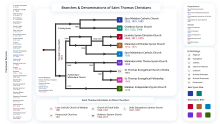کلیسای کاتولیک کلدانی
 کاتدرائیة القدیس یوسف، عنکاوا | |
| بنیانگذار | ریشههای نهایی را دنبال میکند توما، در چت و ماری; در سال ۱۸۳۰ از کلیسای شرق پدید آمد |
|---|---|
| استقلال | دوران حواری |
| به رسمیت شناختهشدن | کلیسای کاتولیک، کلیسای کاتولیک شرقی |
| کشیش راشد | لوئیس رافائل ساکو |
| مقر | بغداد، عراق |
| قلمرو | عراق، ایران، ترکیه، سوریه، لبنان، اردن، اسرائیل، [نیازمند منبع] مصر، ایالات متحده آمریکا، کانادا، استرالیا، نیوزیلند، اتریش، بلژیک، فرانسه، یونان، هلند، دانمارک، آلمان، گرجستان، سوئد، بریتانیا |
| زبان | |
| اعضا | 500,000[۲][۳] |
| وبگاه | Patriarchate of Babylon |
کلیسای کاتولیک کلدانی (سریانی کلاسیک: ܥܕܬܐ ܟܠܕܝܬܐ ܩܬܘܠܝܩܝܬܐ) از کلیساهای وابستهٔ سریانی شرقی کلیسای کاتولیک شرقی تحت سریر مقدس جاثلیق-پاتریارک بابل، است و کمونیون کامل را با پاپ بقیه کلیسای کاتولیک حفظ میکند. هماکنون کلیسای کاتولیک کلدانی از حدود ۵۰۰٬۰۰۰ در شمال عراق، و مناطق مجاور در جنوب غربی ترکیه و شمال غربی ایران تشکیل میشود.
جستارهای وابسته[ویرایش]
منابع[ویرایش]
- ↑ "The Chaldean Catholic Church". CNEWA. Retrieved 11 May 2013.
- ↑ Ronald Roberson. "The Eastern Catholic Churches 2010" (PDF). Catholic Near East Welfare Association. Archived from the original (PDF) on 23 September 2015. Retrieved December 2010.
{{cite web}}: Check date values in:|accessdate=(help) Information sourced from Annuario Pontificio 2010 edition - ↑ «CNEWA - Chaldean Catholic Church». بایگانیشده از اصلی در ۱۶ مارس ۲۰۱۰. دریافتشده در ۱۸ دسامبر ۲۰۱۵.
- مشارکتکنندگان ویکیپدیا. «Chaldean Catholic Church». در دانشنامهٔ ویکیپدیای انگلیسی، بازبینیشده در ۱۸ دسامبر ۲۰۱۵.
| در ویکیانبار پروندههایی دربارهٔ کلیسای کاتولیک کلدانی موجود است. |


